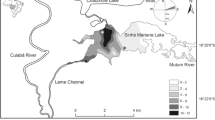Abstract
Measurements made in fresh water wetland have shown that temperature, pH, dissolved oxygen and bicarbonate alkalinity in the hyacinth infested area were lower, but dissolved free carbon dioxide concentration was excitingly greater than in the open water area. This extreme hypoxic and hypercarbic condition of hyacinth covered areas was caused by the thick coverage of Eichhornia crassipes which was crucial for the composition of the characteristic flora and fauna.
Similar content being viewed by others
References
Dale, H. M. & Giliespie, T. J. 1976. The influence of floating vascular plants on the diurnal fluctuations of temperature near the water surface in early spring. Hydrobiol. 49: 245–256.
Mitchell, D. S. 1973. The growth and management of Eichhornia crassipes and Salvinia spp in their native environment and in Alien situations. Aquatic weeds in S.E. Asia ed-C. K. Varshney and J. Rozoska: pp. 167–176, Dr. W. Junk b.v. publishers, Netherlands.
Penford, W. T.& Earle, T. T. 1948. The biology of the water hyacinth. Ecol. Monogr. 18: 447–472.
Rao, A. & Mathur, S. N. 1975. Chemical eradication of Eichhornia. Proc. Ind. Natl. Sci. Acad.
Rai, D. N. & Datta Munshi, J. S. 1977. Observations on diurnal fluctuations of certain physico-chemical factors of three tropical swamps of Darbhanga (India). Comp. Physiol. and Ecol. Vol. 3 (In Press).
Ultsch, G. R. & Anthony, D. S. 1973. The role of the aquatic exchange of carbondioxide in the ecology of the water hyacinth (Eichhornia crassipes). Florida Sci. 36 (1): 16–22.
Ultsch, G. R. 1976. Ecophysiological studies of some metabolic and respiratory adaptations of sirenid salamanders. in: Respiration of Amphibious Vertebrates, ed-G. M. Hughes; pp. 287–312, Academic Press.
Welch, P. S. 1948. Limnological methods. McGraw-Hill Book Co. Inc.
Author information
Authors and Affiliations
Rights and permissions
About this article
Cite this article
Rai, D.N., Datta Munshi, J. The influence of thick floating vegetation (Water hyacinth: Eichhornia crassipes) on the physico — chemical environment of a fresh water wetland. Hydrobiologia 62, 65–69 (1979). https://doi.org/10.1007/BF00012564
Received:
Published:
Issue Date:
DOI: https://doi.org/10.1007/BF00012564




